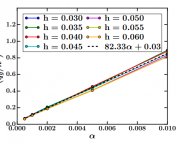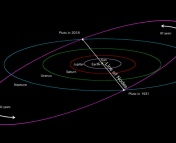- Title: The Measured Compositions of Uranus and Neptune from Their Formation on the CO Iceline
- Authors: Mohamad Ali-Dib, Olivier Mousis, Jean-Marc Petit, and Jonathan I. Lunine
- First Author’s Institution: Universite de Franche-Comte, Institut UTINAM, CNRS/INSU, Observatoire de Besancon, France
There is still much that we don’t understand about the two ice giant planets in our Solar System, Uranus and Neptune. In this paper, the authors posited a new theory that addressed four outstanding problems concerning how these planets formed.
The first problem is that there was likely not enough solid material in the Sun’s protoplanetary disk to build the ice giants at their current locations (19 and 30 AU). Without enough material, the process of giant planet formation couldn’t get off the ground before the protoplanetary disk dispersed.
The second problem is that the ice giants contain more carbon than we would expect. Specifically, their proportion of carbon to hydrogen is 30 to 60 times higher than this same ratio in the Sun. In contrast, Jupiter and Saturn have C/H ratios of only 4 and 7 times higher than the Sun. Why the carbon enrichment of Uranus and Neptune differs so much from that of Jupiter and Saturn is a mystery.
Third, the ice giants are severely depleted in nitrogen. The amount of nitrogen (compared to the amount of hydrogen) is only 1% of the Sun’s N/H value. Jupiter and Saturn, on the other hand, have N/H ratios of about 4 times the Sun’s. Again, the difference in composition between the ice giants and the Jovian planets is striking.
Fourth, from studying the current composition of the ice giants, it appears that the deuterium to hydrogen ratio (D/H) in the water ice that went into building these planets was 6 to 8 times lower than in the water ice of comets that reside on the outer part of the Solar System today. This is surprising because comets are thought to be very pristine specimens from the early stages of the Solar System’s history.
The author’s solution to all four of these problems relied on icelines. Icelines were the locations in the protoplanetary disk where a given compound transitioned between its solid and vapor phases. Inside its iceline a compound was warm enough to be a vapor, while outside the iceline the compound was a solid.
The crux of the authors’ idea was that the ice giants formed between the carbon monoxide (CO) and molecular nitrogen (N2) ice lines. The CO iceline occurs at a temperature of 25 K and the N2 iceline occurs at 24 K. Thus, these lines were quite close together at 28 and 32 AU in the Solar System’s protoplanetary disk.
The authors investigated the physical processes at play near these ice lines by using a computer simulation to model the disk. They found two competing processes that occurred at each iceline. Solid particles experienced gas drag in the disk and moved inwards, crossing the iceline and sublimating. At the same time, gas from just inside the iceline diffused outwards and condensed into solid particles. The second process occured more quickly, dominating over the first. The net effect was to leave the concentration of material enhanced just outside of the iceline and depleted just inside of the iceline.
Because the CO and N2 icelines were so near each other, the region between them was affected by this phenomenon from both icelines. This region of the disk ended up highly concentrated in CO ice, providing the reservoir of solid material needed to form a planet efficiently and solve the first problem. Since CO was the primary source of carbon in the protoplanetary disk, this effect left the planet enriched in CO, solving the second problem (see the pie charts below). This region was also depleted in N2 vapor, leaving the resulting planet lacking in nitrogen and solving problem three.

Pie charts showing the mass fractions of solid material just outside the CO ice line at the start of the authors simulations (left, before the ice line phenomena takes place), and 100,000 years later (right, at the time when the ice giant planets are forming). Note how effectively the ice line concentrates solid CO. (From Figure 4 of the paper).
The fourth problem is solved by realizing that primordial ice (like that found in comets) may not have been the primary source of H2O for the ice giants. In addition to delivering lots of carbon, the concentrated CO also delivered much oxygen. This oxygen could combine with the primordial molecular hydrogen (H2) in the disk to form water with the reaction CO + 3H2 –> CH4 + H2O. The primordial H2 has a much lower D/H than the ice in comets, and the H2O of the ice giants has a D/H ratio much closer to this low value.
So is the question of how Uranus and Neptune completely answered? Not quite. While this theory does solve several underlying problems, it creates a couple of its own as well. For one thing, a leading theory about the dynamical history of the Solar System called the Nice Model requires Uranus and Neptune to start at 15 and 12 AU, which is much nearer the Sun than the location of these icelines (although the planets could have migrated inwards after they formed). Another issue is that there are two ice giant planets, and the zone between the ice lines was likely not large enough to have formed them both. Perhaps one planet formed and migrated out of the region quickly with enough time for the second one to form afterwards. Or perhaps there were fluctuations in temperature profile of the protoplanetary disk, leaving multiple concentric pairs of CO and N2 icelines at which to form ice giants.
The authors do mention one way to test their theory further: measure the amount of oxygen in the ice giants. Because carbon and oxygen are both primarily delivered to the planets in the form of condensed CO molecules, their theory predicts that the amount of C and O should be roughly the same.






they are both captured objects.